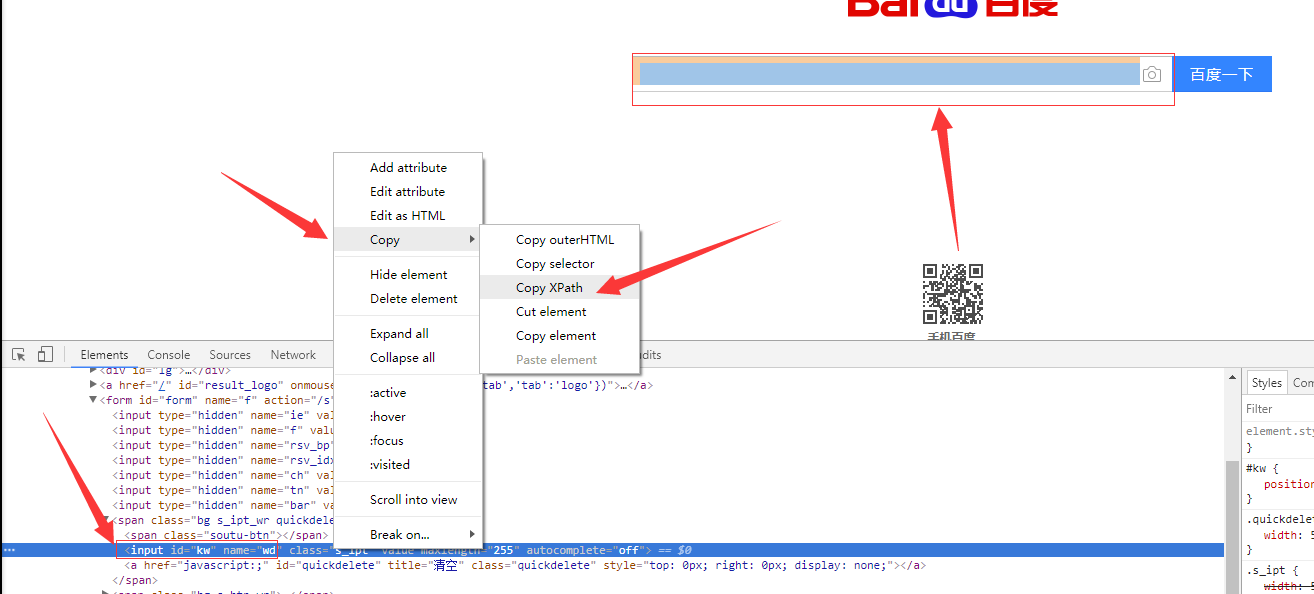
Many languages can crawl, but crawlers based on python are more concise and convenient. Crawlers have also become an essential part of the python language. There are also many ways to parse crawlers. The previous article told you about the fourth method of parsing crawlers: PyQuery. Today I bring you another method, XPath.

The basic use of xpath for python crawlers
1. Introduction
XPath is a language for finding information in XML documents. XPath can be used to traverse elements and attributes in XML documents. XPath is a major element of the W3C XSLT standard, and both XQuery and XPointer are built on XPath expressions.
2. Installation
pip3 install lxml
3. Use
1 , Import
from lxml import etree
2. Basic usage
from lxml import etree
wb_data = """
<div>
<ul>
<li class="item-0"><a href="link1.html">first item</a></li>
<li class="item-1"><a href="link2.html">second item</a></li>
<li class="item-inactive"><a href="link3.html">third item</a></li>
<li class="item-1"><a href="link4.html">fourth item</a></li>
<li class="item-0"><a href="link5.html">fifth item</a>
</ul>
</div>
"""
html = etree.HTML(wb_data)
print(html)
result = etree.tostring(html)
print(result.decode("utf-8"))From the results below, our printer html is actually a python object, and etree.tostring(html) is The basic writing method of html in Buquanli completes the tags that are missing arms and legs.
<Element html at 0x39e58f0>
<html><body><div>
<ul>
<li class="item-0"><a href="link1.html">first item</a></li>
<li class="item-1"><a href="link2.html">second item</a></li>
<li class="item-inactive"><a href="link3.html">third item</a></li>
<li class="item-1"><a href="link4.html">fourth item</a></li>
<li class="item-0"><a href="link5.html">fifth item</a>
</li></ul>
</div>
</body></html> 3. Get the content of a certain tag (basic use). Note that to get all the content of the a tag, there is no need to add a forward slash after a, otherwise an error will be reported.
Writing method one
html = etree.HTML(wb_data)
html_data = html.xpath('/html/body/div/ul/li/a')
print(html)
for i in html_data:
print(i.text)
<Element html at 0x12fe4b8> first item second item third item fourth item fifth item
Writing method two (Directly in the tag where you need to find the content Just add a /text() after it)
html = etree.HTML(wb_data)
html_data = html.xpath('/html/body/div/ul/li/a/text()')
print(html)
for i in html_data:
print(i)<Element html at 0x138e4b8> first item second item third item fourth item fifth item
#使用parse打开html的文件
html = etree.parse('test.html')
html_data = html.xpath('//*')<br>#打印是一个列表,需要遍历
print(html_data)
for i in html_data:
print(i.text)html = etree.parse('test.html') html_data = etree.tostring(html,pretty_print=True) res = html_data.decode('utf-8') print(res)
<div>
<ul>
<li class="item-0"><a href="link1.html">first item</a></li>
<li class="item-1"><a href="link2.html">second item</a></li>
<li class="item-inactive"><a href="link3.html">third item</a></li>
<li class="item-1"><a href="link4.html">fourth item</a></li>
<li class="item-0"><a href="link5.html">fifth item</a></li>
</ul>
</div>html = etree.HTML(wb_data)
html_data = html.xpath('/html/body/div/ul/li/a/@href')
for i in html_data:
print(i)link1.html link2.html link3.html link4.html link5.html
html = etree.HTML(wb_data)
html_data = html.xpath('/html/body/div/ul/li/a[@href="link2.html"]/text()')
print(html_data)
for i in html_data:
print(i)7. Above we found all absolute paths (each one is searched from the root), below we find relative paths, for example, find the a tag content under all li tags.
html = etree.HTML(wb_data)
html_data = html.xpath('//li/a/text()')
print(html_data)
for i in html_data:
print(i)['first item', 'second item', 'third item', 'fourth item', 'fifth item'] first item second item third item fourth item fifth item
html = etree.HTML(wb_data)
html_data = html.xpath('//li/a//@href')
print(html_data)
for i in html_data:
print(i)['link1.html', 'link2.html', 'link3.html', 'link4.html', 'link5.html'] link1.html link2.html link3.html link4.html link5.html
9. The method of checking specific attributes under relative paths is similar to that under absolute paths, or it can be said to be the same.
html = etree.HTML(wb_data)
html_data = html.xpath('//li/a[@href="link2.html"]')
print(html_data)
for i in html_data:
print(i.text)[<Element a at 0x216e468>] second item
10、查找最后一个li标签里的a标签的href属性
html = etree.HTML(wb_data)
html_data = html.xpath('//li[last()]/a/text()')
print(html_data)
for i in html_data:
print(i)
打印:
['fifth item'] fifth item
11、查找倒数第二个li标签里的a标签的href属性
html = etree.HTML(wb_data)
html_data = html.xpath('//li[last()-1]/a/text()')
print(html_data)
for i in html_data:
print(i)
打印:
['fourth item'] fourth item
12、如果在提取某个页面的某个标签的xpath路径的话,可以如下图:
//*[@id="kw"]
解释:使用相对路径查找所有的标签,属性id等于kw的标签。

#!/usr/bin/env python
# -*- coding:utf-8 -*-
from scrapy.selector import Selector, HtmlXPathSelector
from scrapy.http import HtmlResponse
html = """<!DOCTYPE html>
<html>
<head>
<meta charset="UTF-8">
<title></title>
</head>
<body>
<ul>
<li><a id='i1' href="link.html">first item</a></li>
<li><a id='i2' href="llink.html">first item</a></li>
<li><a href="llink2.html">second item<span>vv</span></a></li>
</ul>
<div><a href="llink2.html">second item</a></div>
</body>
</html>
"""
response = HtmlResponse(url='http://example.com', body=html,encoding='utf-8')
# hxs = HtmlXPathSelector(response)
# print(hxs)
# hxs = Selector(response=response).xpath('//a')
# print(hxs)
# hxs = Selector(response=response).xpath('//a[2]')
# print(hxs)
# hxs = Selector(response=response).xpath('//a[@id]')
# print(hxs)
# hxs = Selector(response=response).xpath('//a[@id="i1"]')
# print(hxs)
# hxs = Selector(response=response).xpath('//a[@href="link.html"][@id="i1"]')
# print(hxs)
# hxs = Selector(response=response).xpath('//a[contains(@href, "link")]')
# print(hxs)
# hxs = Selector(response=response).xpath('//a[starts-with(@href, "link")]')
# print(hxs)
# hxs = Selector(response=response).xpath('//a[re:test(@id, "i\d+")]')
# print(hxs)
# hxs = Selector(response=response).xpath('//a[re:test(@id, "i\d+")]/text()').extract()
# print(hxs)
# hxs = Selector(response=response).xpath('//a[re:test(@id, "i\d+")]/@href').extract()
# print(hxs)
# hxs = Selector(response=response).xpath('/html/body/ul/li/a/@href').extract()
# print(hxs)
# hxs = Selector(response=response).xpath('//body/ul/li/a/@href').extract_first()
# print(hxs)
# ul_list = Selector(response=response).xpath('//body/ul/li')
# for item in ul_list:
# v = item.xpath('./a/span')
# # 或
# # v = item.xpath('a/span')
# # 或
# # v = item.xpath('*/a/span')
# print(v)The above is the detailed content of Crawler parsing method five: XPath. For more information, please follow other related articles on the PHP Chinese website!